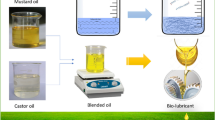Abstract
Purpose
While the application of Life Cycle Assessment (LCA) to lubricants can be considered fully operational for general purposes outside the lubricants industry, where Life Cycle Inventories (LCIs) of mineral and synthetic base oils can be used interchangeably and where additives can be excluded, this is not the case for research and development purposes within the industry. Previous LCAs of base oils are not sufficiently detailed and comprehensive for R&D purposes, and there are no LCAs of lube additives and fully formulated lubricants. The aim of this paper is to integrate and expand previous LCAs of base oils and to investigate on the contribution of lube additives to the environmental impacts of a fully formulated lubricant.
Materials and methods
This study considers three base oils (mineral, poly-alpha-olefins (PAO) and hydrocracked) and a set of lubricating additives typically used in fully formulated engine oil. The LCA model is based on both industry and literature data.
Results and discussion
Trends in the lubricants industry towards more sophisticated base oils correspond to remarkably higher environmental impacts per kilogram of product but lead to reduced impacts per kilometre. The contribution of additives to the life cycle impacts of commercial lube oil was found to be remarkably high for some impact categories (nearly 35 % for global warming).
Conclusions
As base oil is concerned, this study made the point on data availability and provided a contribution in order to integrate and expand previous LCAs of mineral base oil and PAO. On the side of additives, the main conclusion is that in modern lubricants, the contribution of additives in terms of environmental impact can be remarkably high and, therefore, they should not be excluded.






Similar content being viewed by others
References
Barnes AM, Bartle KD, Thibon VRA (2001) A review of zinc dialkyldithiophosphates (ZDDPS): characterisation and role in the lubricating oil. Tribol Int 34(6):389–395
Bevilacqua M, Braglia M (2002) Environmental efficiency analysis for ENI oil refineries. J Clean Prod 10(1):85–92
Boustead Model 5.0 (2005) Operating manual. Boustead Consulting Ltd., HORSHAM, West Sussex, UK
EC, JRC, IES (2010) ELCD core database version II. European Commission, Joint Research Centre, Institute for Environment and Sustainability, Ispra (VA), Italy. Available at http://lct.jrc.ec.europa.eu/assessment/data
Ecoinvent (2007) Life cycle inventories of chemicals—Ecoinvent report no. 8. Swiss Centre for Life Cycle Inventories, Zürich and Dübendorf
Ekman A, Börjesson P (2011) Life cycle assessment of mineral oil-based and vegetable oil-based hydraulic fluids including comparison of biocatalytic and conventional production methods. Int J Life Cycle Assess 16(4):297–305
European Commission DG Energy (2010a) Commission staff working paper on refining and the supply of petroleum products in the EU.
European Commission DG Energy (2010b) Registration of crude oil imports and deliveries in the European Union (EU27)
European IPPC Bureau (2003) BREF—reference document on best available techniques for mineral oil and gas refineries. European Commission, Brussels
Fehrenbach H (2005) Ecological and energetic assessment of re-refining used oils to base oils: substitution of primarily produced base oils including semi-syntheticand synthetic compounds. IFEU Ltd. (commisioned by GEIR - Groupement Européen de l'Industrie de la Régénération), Heidelberg
Feldman Y, Frey GL, Homyonfer M, Lyakhovitskaya V, Margulis L, Cohen H, Hodes G, Hutchison JL, Tenne R (1996) Bulk synthesis of inorganic fullerene-like MS2 (M = Mo, W) from the respective trioxides and the reaction mechanism. J Am Chem Soc 118(23):5362–5367
Feldman Y, Zak A, Popovitz-Biro R, Tenne R (2000) New reactor for production of tungsten disulfide hollow onion-like (inorganic fullerene-like) nanoparticles. Solid State Sci 2(6):663–672
Greene SV, Gatto VJ (1999) Size-exclusion chromatography method for characterizing low-molecular-mass antioxidant lubricant additives. J Chromatogr A 841(1):45–54
Hudson LK, Eastoe J, Dowding PJ (2006) Nanotechnology in action: overbased nanodetergents as lubricant oil additives. Adv Colloid Interface Sci 123–126:425–431
Hui F, Machtalère G, Xie J, Kolodziejczyk H, Rosset R (1997) Isolation of polybutenylsuccinimide-type dispersants from multigrade lubricating oils by classical cation exchange chromatography. Anal Chim Acta 339(1–2):109–113
ELCD core database version II (2010).
Jolliet O, Margni M, Charles R, Humbert S, Payet J, Rebitzer G, Rosenbaum R (2003) IMPACT 2002+: a new life cycle impact assessment methodology. Int J Life Cycle Assess 8(6):324–330
Lin YC, So H (2004) Limitations on use of ZDDP as an antiwear additive in boundary lubrication. Tribol Int 37(1):25–33
Mang T, Dresel W (2007) Lubricants and lubrication. Wiley, Weinheim
Miller SA, Landis AE, Theis TL, Reich RA (2007) A comparative life cycle assessment of petroleum and soybean-based lubricants. Environ Sci Technol 41(11):4143–4149
Mortier R, Orszulik S (1997) Chemistry and technology of lubricants. Chapman & Hall, London
Rudnick L (2009) Lubricant additives: chemistry and applications. CRC, Boca Raton
Serra-Holm V (2004) Life cycle assessment (LCA) from cradle to gate of base oils used in the production of lubricants. In: Technische Akademie Esslingen international tribology colloquium proceedings, 2004. pp 549–552
Souza de Carvalho MJ, Rudolf Seidl P, Pereira Belchior CR, Ricardo Sodré J (2010) Lubricant viscosity and viscosity improver additive effects on diesel fuel economy. Tribol Int 43(12):2298–2302
Vag C, Marby A, Kopp M, Furberg L, Norrby T (2002) A comparative life cycle assessment of the manufacture of base fluids for lubricants. J Synthetic Lubric 19(1):39–57
Varlot K, Kasrai M, Bancroft GM, Yamaguchi ES, Ryason PR, Igarashi J (2001) X-ray absorption study of antiwear films generated from ZDDP and borate micelles. Wear 249(12):1029–1035
Wang M, Lee H, Molburg J (2004) Allocation of energy use in petroleum refineries to petroleum products. Int J Life Cycle Assess 9(1):34–44
Acknowledgments
Support for this research was provided by the European Commission through the 7th framework programme project AddNano (http://sites.google.com/site/addnanoeu/). The authors would like to thank the staff of PETRONAS Lubricants International, Infineum UK Ltd. and Centro Ricerche Fiat for the valuable comments and support.
Author information
Authors and Affiliations
Corresponding author
Additional information
Responsible editor: Marzia Traverso
Rights and permissions
About this article
Cite this article
Raimondi, A., Girotti, G., Blengini, G.A. et al. LCA of petroleum-based lubricants: state of art and inclusion of additives. Int J Life Cycle Assess 17, 987–996 (2012). https://doi.org/10.1007/s11367-012-0437-4
Received:
Accepted:
Published:
Issue Date:
DOI: https://doi.org/10.1007/s11367-012-0437-4




